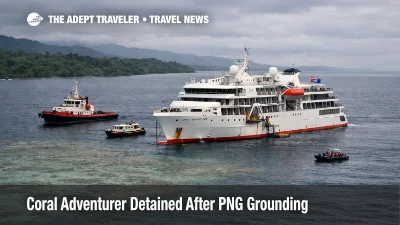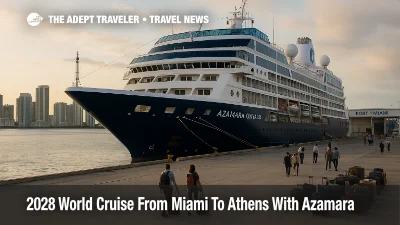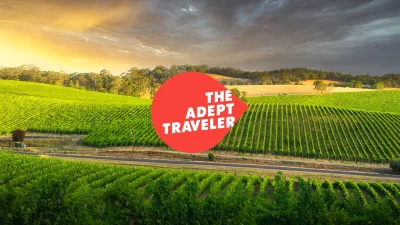Papua New Guinea
Papua New Guinea, often considered one of the last frontiers of adventure travel, offers an unparalleled opportunity to explore a land brimming with natural beauty and cultural diversity. Travelers who venture to this Pacific gem will find themselves immersed in lush rainforests, crystalline waters, and towering mountain ranges that are home to countless exotic species. Papua New Guinea is a treasure trove for those passionate about diving, boasting some of the world's most pristine coral reefs teeming with marine life. Cultural enthusiasts will be entranced by the country's vibrant traditions, with over 800 distinct languages and numerous local festivals that offer a glimpse into the rich heritage of its people. Trekking through the imposing Kokoda Trail is a rite of passage for many, tracing the historical pathways forged during World War II. The capital, Port Moresby, serves as a gateway to the country's myriad attractions, combining cosmopolitan flair with easy access to secluded natural wonders. Traveling to Papua New Guinea is like stepping into a living museum of anthropology and natural splendor, where every encounter promises to be an unforgettable experience. Whether you're diving in the turquoise bays of Milne Bay, navigating the Sepik River's intricate waterways, or simply soaking up the warm hospitality of the local communities, a travel itinerary to Papua New Guinea ensures a rich tapestry of adventures waiting to be discovered.
The History of Papua New Guinea
When you travel to Papua New Guinea, you embark on a journey through time, exploring a land rich with history and culture. Papua New Guinea is an awe-inspiring destination where ancient traditions meet the echoes of colonial history. As one of the most diverse countries in the world, both culturally and linguistically, it offers an unparalleled experience for history enthusiasts and curious travelers alike. From the intricate tribal customs to the indelible marks left by European explorers, Papua New Guinea beckons with tales of a time immemorial.
Pre-Colonial Era: Age-Old Traditions
Long before Europeans set foot on Papua New Guinea, its indigenous population thrived in a complex and culturally rich society. The island boasts the earliest evidence of agriculture found anywhere in the world, dating back to 7,000 BC. Traditional methods of farming, hunting, and fishing have been passed down through generations, preserving a way of life that predates modern history. When you travel to Papua New Guinea, you'll discover numerous tribal communities, each with its own language, customs, and artistic expressions. The intricate facial tattoos, elaborate headdresses, and ceremonial dance performances you'll witness are remnants of a storied past, showcasing an unbroken lineage of cultural heritage.
Colonial Influence: Encounters and Change
The history of Papua New Guinea took a dramatic turn upon the arrival of European explorers in the 16th century. First sighted by Portuguese and Spanish navigators, the island later attracted the attention of the British and the Germans. By the late 19th century, Papua was claimed by the British, while New Guinea fell under German control. The imprints of these colonial days are still visible today when you travel to Papua New Guinea, especially in towns like Kokopo and Rabaul. Structures built during this period, along with missionary schools and churches, offer a glimpse into the transformative impact foreign powers had on the island’s social and economic landscape.
World War II: The Battlegrounds
World War II left an indelible mark on Papua New Guinea, as it became a significant battleground in the Pacific Theatre. The Kokoda Track and the beaches of Milne Bay witnessed some of the fiercest fighting between Allied and Japanese forces. Travel to Papua New Guinea and you can walk the very paths that soldiers once tread during these monumental battles. War relics, such as wrecked aircraft and sunken ships, now serve as poignant reminders of a world at war. Museums and memorials scattered throughout the country pay homage to this turbulent chapter in history, making it a deeply moving experience for those who visit.
Modern Era: Independence and Growth
On September 16, 1975, Papua New Guinea achieved independence from Australia, marking the start of a new era. The nation has since worked tirelessly to blend traditional ways of life with modern advancements. When you travel to Papua New Guinea today, you can see how urban areas like Port Moresby and Lae have developed, incorporating modern infrastructure while retaining cultural authenticity. Local markets bustle with activity, offering everything from handcrafted artifacts to modern goods, embodying the resilient spirit of a nation that honors its past while striding confidently into the future.
Travel to Papua New Guinea to immerse yourself in a history that spans millennia. Whether it's the ancient tribal traditions, the colonial architecture, the solemn war memorials, or the dynamic blend of old and new, Papua New Guinea promises a historical journey like no other, offering an enriching experience that will leave a lasting impression.
The Culture of Papua New Guinea
Travel to Papua New Guinea and immerse yourself in a tapestry of vibrant cultures, each with its unique traditions, languages, and art forms. Home to over 800 languages and diverse cultural practices, Papua New Guinea is a living museum for anyone interested in anthropology and the dynamic expressions of human creativity. The sheer variety of tribal groups, from the charismatic Huli Wigmen in the Highlands to the coastal Tolai people of East New Britain, offers a unique journey that one simply cannot experience anywhere else on the planet. When you travel to Papua New Guinea, you get the opportunity to witness centuries-old customs that are still very much alive and integral to the social fabric of the country.
During your travel to Papua New Guinea, one of the most captivating experiences is witnessing the traditional sing-sings. These are not mere performances but a profound way through which tribes express their identity, history, and lore. Imagine dozens of tribes, each one adorned in elaborate costumes made from feathers, shells, and natural paints, performing synchronized dances and songs that echo ancient tales. By attending one of these exhibitions, such as the Goroka Show or the Mount Hagen Cultural Show, you are not just a spectator but a participant in a cultural phenomenon that transcends time. Few travel destinations offer this level of cultural authenticity.
Engaging with the People
The hospitality of the Papua New Guinea people is as rich and varied as their culture. From the moment you set foot in the country, you are greeted with warmth and curiosity. The people of Papua New Guinea are known for their genuine friendliness and eagerness to share their culture with visitors. Visiting villages provides an intimate glimpse into their daily lives, from traditional cooking methods to age-old crafts like weaving and pottery. These interactions, often facilitated through local guides, ensure that your travel to Papua New Guinea is both enlightening and deeply personal.
Unique Art and Craft
Art and craft are pivotal in Papua New Guinea's cultural landscape. The intricate bilum bags, crafted from woven strands of plant fibers, are both functional and artistic representations of the people’s ingenuity. Similarly, the totemic artifacts, masks, and other wooden carvings are not merely souvenirs but symbols laden with cultural significance. When you travel to Papua New Guinea, visiting the local markets and artisans’ workshops allows you to purchase these unique items directly from the craftsmen. This not only supports the local economy but also offers you pieces imbued with meaning and tradition to take back home.
Embracing the culture and people of Papua New Guinea is an unparalleled experience that offers much more than a typical holiday. It’s a journey into one of the world’s last frontiers of authentic cultural preservation. Travel to Papua New Guinea, where every moment is a chance to connect with remarkable traditions and form lasting memories with some of the most welcoming people you will ever meet. If you seek an adventure that enriches your understanding of the world and its myriad cultures, Papua New Guinea is your ultimate destination.
The Food of Papua New Guinea
When you travel to Papua New Guinea, you're not just embarking on an adventure to a distant land; you're stepping into a culinary paradise that promises a feast for the senses. Papua New Guinea's unique culinary tradition is a gourmet's dream, blending ancient cooking methods with exotic local ingredients that will tantalize your taste buds. From the first bite to the last sip, every meal tells a story of the island nation's rich heritage and vibrant culture. Prepare to be captivated by the island's diverse food scene, where traditional dishes stand alongside modern interpretations, offering travelers an unforgettable gastronomic experience.
The heart and soul of Papua New Guinea's cuisine lie in its traditional cooking methods, which have been passed down through generations. When you travel to Papua New Guinea, you'll quickly notice that many dishes are prepared using open fires and earthen ovens, known locally as "mumus." This method involves wrapping meat, vegetables, and aromatic herbs in banana leaves and cooking them slowly over hot stones. The result is a symphony of flavors, with tender meats and fresh produce absorbing the subtle smokiness of the wood fire. A must-try dish is the classic "mumu," featuring sweet potatoes, taro, and chicken or pork marinated in tangy and spicy sauces made from local ingredients like ginger and coconut milk.
As you travel through Papua New Guinea, you'll discover an abundance of exotic fruits and vegetables that dominate the local diet. Markets burst with the vibrant colors of tropical fruits such as rambutan, soursop, and pawpaw, all of which add a delightful freshness to meals. The seafood is another highlight, given the country's extensive coastline and pristine waters. Feast on the freshest catches from the Pacific, including succulent prawns, reef fish, and crayfish, often lightly grilled or cooked in coconut milk for a delicate, melt-in-your-mouth experience. Moreover, the use of native spices like ginger, garlic, and chili peppers enhances every dish, providing bold flavors that reflect the region's diverse cultural influences.
Travel to Papua New Guinea also offers the opportunity to sample unique beverages that are as intriguing as the local cuisine. The nation's coffee is globally renowned, grown in high-altitude regions that produce beans with a distinctive flavor profile, often described as smooth, full-bodied, and slightly fruity. Don't miss the chance to savor a cup of freshly brewed Papua New Guinea coffee, whether you prefer it black, with milk, or as part of a delicious, creamy concoction. Alongside coffee, you can enjoy traditional herbal teas that offer various health benefits and a taste of indigenous customs. Kava is another traditional drink worth exploring; it's a ceremonial beverage made from the root of the kava plant that offers a calming effect, perfect for unwinding after a day of exploration.
What to See and Do in Papua New Guinea
Travel to Papua New Guinea is an adventure that promises to provide an unforgettable experience. Rich in cultural diversity, stunning landscapes, and unique wildlife, this incredible country has something to offer every traveler. Here are ten must-do activities in Papua New Guinea that will help you make the most of your journey.
1. Explore the Sepik River
The Sepik River, one of the largest and most biodiverse rivers in Papua New Guinea, offers travelers an authentic glimpse into traditional village life. Navigating through the river's intricate network of waterways, you'll encounter communities renowned for their intricate wood carvings and cultural artifacts. Make sure to visit the village of Pagwi, Papua New Guinea, where you can experience a local market and witness the daily lives of the people living along this majestic river.
2. Visit the National Museum and Art Gallery
Port Moresby, Papua New Guinea, is home to the National Museum and Art Gallery. This site is an indispensable stop for anyone who wants to understand the rich history and cultural heritage of Papua New Guinea. The museum offers collections that range from archaeology and anthropology to ethnography and natural history, showcasing artifacts that tell the story of the country’s diverse cultural landscape.
3. Trek the Kokoda Trail
For those seeking a physical challenge combined with historical significance, trekking the Kokoda Trail is a must. This 96-kilometer trail links Port Moresby, Papua New Guinea to the village of Kokoda. It was the site of a significant World War II campaign, and today, the trek attracts adventure travelers looking to experience its rugged terrain, stunning mountain vistas, and important historical landmarks.
4. Snorkel or Dive in Kimbe Bay
Kimbe Bay, Papua New Guinea, is a haven for marine biodiversity. Travelers can snorkel or dive to explore its vibrant coral reefs, which are home to over 900 species of fish and nearly 400 species of coral. Whether you're a novice or an experienced diver, Kimbe Bay offers an underwater adventure unlike any other.
5. Experience the Goroka Show
Held annually in September in Goroka, Papua New Guinea, the Goroka Show is one of the country's largest cultural festivals. It features traditional music, dance, costumes, and rituals from over 100 different tribes. This event provides a unique opportunity for travelers to immerse themselves in the rich cultural tapestry of Papua New Guinea.
6. Relax at Loloata Island
Just a short boat ride from Port Moresby, Loloata Island, Papua New Guinea, offers a tranquil escape. Known for its clear waters and relaxed atmosphere, it's a perfect spot for leisurely activities such as beach lounging, snorkeling, and wildlife spotting. The island’s marine life is abundant, making it a snorkeler's paradise.
7. Visit the Highlands
The Highlands region of Papua New Guinea is known for its dramatic landscapes, cool climate, and unique tribal cultures. Mount Hagen is a good starting point for exploring this area. Visit local markets, engage with the tribal communities, and attend traditional "sing-sings" where different tribes showcase their unique cultural identities through music and dance.
8. Discover Milne Bay
Milne Bay Province, Papua New Guinea, offers some of the most pristine and unexplored diving sites in the world. With its impressive coral reefs, WWII warplanes, and shipwrecks, Milne Bay is a diver's dream. Noteworthy sites include the wreck of the B-17 Bomber "Blackjack" and the Wahoo Point dive site, known for its steep wall dives and pelagic species.
9. Tour the Trobriand Islands
The Trobriand Islands, Papua New Guinea, often referred to as the "Islands of Love," are famous for their unique matrilineal society and elaborate yam harvest festivals. Located in the Milne Bay Province, these islands offer an opportunity to engage with a culture that has preserved many of its ancient traditions and ways of life. Participate in local ceremonies, and explore the stunning landscapes and pristine beaches.
10. Visit the War Relics in Rabaul
Rabaul, Papua New Guinea, offers a wealth of historical sites related to its significant role in World War II. Visit the Japanese tunnels, the wreck of the Japanese submarine I-400, and the Tavurvur volcano, which provides a dramatic backdrop to this historic town. The Rabaul War Museum is another must-visit for history enthusiasts, offering a detailed look at the area's wartime history.
When you travel to Papua New Guinea, you’ll find a country that is richly diverse, offering a multitude of experiences that cater to every type of traveler. From its vibrant indigenous cultures to its stunning natural landscapes, Papua New Guinea stands out as a unique destination that promises endless adventure and discovery.
Why You Should Travel to Papua New Guinea
Travelers are drawn to Papua New Guinea for its unparalleled natural beauty and rich cultural heritage. This remote destination offers a unique, off-the-beaten-path experience, where pristine rainforests, volcanic landscapes, and vibrant coral reefs create a paradise for nature enthusiasts. When you travel to Papua New Guinea, you step into a world where biodiversity thrives—with nearly 5 percent of the world's known species found here. Bird watchers flock to the country to catch a glimpse of the striking Birds of Paradise, while divers are captivated by some of the best underwater ecosystems on the planet, teeming with colorful fish, mysterious wrecks, and intricate coral formations.
Another compelling reason to travel to Papua New Guinea is its extraordinary cultural diversity. Home to over 800 distinct languages and ethnic groups, Papua New Guinea is a living mosaic of traditional societies and customs. Each community has its own rituals, art, and dance, offering travelers a rare opportunity to witness and engage with indigenous traditions that have been preserved for centuries. Events like the Mount Hagen Cultural Show and the Goroka Festival are spectacular showcases of traditional attire, dance, and music, drawing visitors from around the world eager to experience the rich tapestry of Papua New Guinea's cultural landscape.
Adventurers seeking thrilling and immersive experiences will find plenty to love when they travel to Papua New Guinea. The rugged terrain offers countless opportunities for hiking, trekking, and exploring uncharted areas. Whether it's scaling the peaks of the Owen Stanley Range, navigating the dense wilderness of the Sepik River, or discovering the historical significance of the Kokoda Track, Papua New Guinea provides an adrenaline-packed backdrop for those eager to step outside their comfort zone. Additionally, the warmth and hospitality of the local people enhance these adventures, making each journey a memorable and enriching experience.
Why You Must Travel to Papua New Guinea
If you seek a destination that combines natural splendor, cultural richness, and exhilarating adventures, you must travel to Papua New Guinea. This extraordinary country offers a unique blend of experiences that cater to every aspect of an intrepid traveler’s dream. From its awe-inspiring landscapes and diverse wildlife to its vibrant and celebratory cultural practices, Papua New Guinea promises an unforgettable journey that not many places on Earth can rival. By traveling to Papua New Guinea, you not only embark on a captivating expedition but also support the preservation of one of the planet's most pristine and culturally diverse regions. Your travel to Papua New Guinea will be a transformative adventure filled with remarkable discoveries and profound connections, making it an essential destination for your travel bucket list.
Tips & Tricks for Traveling in Papua New Guinea
Planning travel to Papua New Guinea offers an array of spectacular experiences and unique cultural immersions. This island nation, located in the southwestern Pacific, is a hidden gem waiting to be explored. Here are some detailed tips and tricks to make your Papua New Guinea travel experience smoother and more enjoyable.
1. Understand Local Customs and Etiquette
Travel to Papua New Guinea involves engaging with rich and diverse cultures. More than 800 languages are spoken, and numerous tribes maintain traditional ways of life. Before you travel, familiarize yourself with local customs. Respect traditions, ask for permission before taking photos, and greet people with a smile. Understanding the distinction between different cultural practices will greatly enhance your trip.
2. Plan Ahead for Accommodations
Papua New Guinea offers various lodging options, from luxury hotels to eco-lodges and guesthouses. Due to the limited infrastructure in remote areas, accommodations can fill up quickly, especially during festival seasons and peak travel times. Booking in advance ensures that you have a comfortable place to stay and can focus on the adventure aspects of your travel to Papua New Guinea.
3. Health and Safety Precautions
Travel to Papua New Guinea requires certain health precautions. Vaccinations for hepatitis A, typhoid, and yellow fever (if traveling from an infected area) are recommended. Additionally, malaria is a risk, so taking prophylactic medication and other preventive measures like using mosquito repellent and nets is essential. Stay updated on health advice to enjoy your trip with peace of mind.
4. Engage Local Guides
Local guides can provide invaluable insights into Papua New Guinea’s diverse landscapes and cultures. They know the best hiking trails, diving spots, and cultural sites. By hiring local guides, you also contribute to the local economy and have a more authentic experience. They can navigate the often challenging terrains and help you connect with local communities.
5. Be Prepared for Cash Transactions
While credit cards are becoming more widely accepted in urban areas, cash is still king in many parts of Papua New Guinea. ATMs are available in major towns but might not be in remote areas. Carry sufficient local currency (Papua New Guinea Kina) to cover your expenses, especially when traveling to remote locations. Always keep some cash handy for smaller transactions and tips.
6. Secure Necessary Permits
Certain areas in Papua New Guinea require permits for entry, especially protected sites and conservation areas. Securing these permits in advance can save you from potential travel disruptions. Check the requirements for each destination you plan to visit and allocate time for processing. Doing so ensures a hassle-free travel experience.
7. Connectivity and Communication
Internet access can be intermittent outside major cities, so plan accordingly. Purchase a local SIM card for better connectivity, as it’s more reliable than roaming services. Inform your accommodation and guides of your arrival and departure times in advance, as communication channels may be limited during your stay. To stay connected, opt for accommodations that offer Wi-Fi.
8. Embrace the Local Cuisine
Travel to Papua New Guinea offers an excellent opportunity to savor local cuisine. Traditional dishes like Mumu (a dish cooked in an earth oven) and fresh seafood are must-tries. Visit local markets and restaurants to try local specialties. Embrace the culinary diversity and dive into the vibrant food culture that Papua New Guinea has to offer.
9. Respect the Environment
Papua New Guinea is home to some of the most biodiverse ecosystems in the world. When visiting natural sites, practice eco-friendly travel habits. Avoid littering, respect wildlife, and stick to designated trails. Participate in community-based conservation programs and support eco-tourism initiatives. Your respectful behavior ensures the preservation of these pristine environments for future travelers.
10. Learn Basic Phrases in Tok Pisin
While English is widely spoken, learning a few phrases in Tok Pisin can be very helpful. This widely spoken creole language can break the ice and endear you to locals. Phrases like “Monin” (Good morning), “Tenkyu” (Thank you), and “Plis” (Please) show respect and willingness to engage with the local culture. Locals appreciate the effort and it enhances your travel experience in Papua New Guinea.
With these tips and tricks, your travel to Papua New Guinea will surely be a memorable and enriching experience. Each aspect, from cultural understanding to practical preparations, will ensure a captivating journey through one of the world’s most diverse and beautiful destinations.
Other Places You Might Like
Bali, Indonesia - When you travel to Papua New Guinea, you might also love Bali, Indonesia, a place where natural beauty seamlessly mingles with cultural richness. Known for its lush forests, pristine beaches, and vibrant Hindu culture, Bali offers an enchanting experience. Whether exploring the ancient temples of Uluwatu and Tanah Lot, scuba diving in the coral-rich waters of Amed, or experiencing the artistic ambiance of Ubud, Bali will captivate any traveler with its magic. Its balance of serene natural landscapes and immersive cultural activities makes it a destination that resonates well with those who appreciate the unspoiled beauty of Papua New Guinea.
Chiang Mai, Thailand - Nestled in the mountainous region of northern Thailand, Chiang Mai offers an entirely different flavor for travelers who love Papua New Guinea. This city is rich in history and culture, with over 300 Buddhist temples. Whether you're trekking to visit the Hill Tribes, exploring the vibrant night markets, or immersing yourself in a monk-led meditation retreat, Chiang Mai provides an array of enriching experiences. Its close connection with nature and indigenous cultures will surely appeal to anyone captivated by Papua New Guinea's unique blend of traditions and landscapes.
Queenstown, New Zealand - For those who thrive on adventure and outdoor activities, Queenstown in New Zealand is a must-visit. Known as the "Adventure Capital of the World," Queenstown offers activities such as bungee jumping, skydiving, and jet boating. Its stunning natural landscape, including Lake Wakatipu and the Remarkables mountain range, makes it a paradise for nature lovers. Much like the rugged terrain and breathtaking vistas of Papua New Guinea, Queenstown promises an exhilarating experience set against a backdrop of unparalleled natural beauty.
Kathmandu, Nepal - The capital city of Nepal, Kathmandu, is an intriguing destination for travelers who love Papua New Guinea because of its rich history and the allure of the Himalayas. The city is an eclectic mix of ancient architecture, bustling bazaars, and myriad cultural sites such as the Swayambhunath (Monkey Temple) and the Pashupatinath Temple. The vibrant culture, combined with the opportunity for amazing trekking experiences in the nearby Himalayas, makes Kathmandu a fascinating destination for those who appreciate the cultural depth and natural splendor akin to Papua New Guinea.
San José, Costa Rica - Located in the heart of Central America, San José is another destination that will captivate lovers of Papua New Guinea. Costa Rica's capital city is a gateway to stunning natural attractions, including volcanoes, rainforests, and wildlife reserves. The surrounding countryside offers ample opportunities for eco-tourism, with activities such as zip-lining in the Monteverde Cloud Forest, white-water rafting, and exploring the biodiverse Corcovado National Park. The emphasis on sustainability and the rich biodiversity in San José echoes the pristine environments found in Papua New Guinea.
Cusco, Peru - The historic city of Cusco in Peru offers a deep dive into the ancient Incan civilization and is a gateway to the renowned Machu Picchu. Much like a journey through Papua New Guinea, exploring Cusco allows travelers to learn about indigenous cultures and traditions. Visiting the Sacred Valley, participating in traditional Andean rituals, and hiking the Inca Trail are just some of the memorable experiences awaiting in Cusco. The city's rich history and awe-inspiring landscapes provide a fascinating parallel to the adventures to be had in Papua New Guinea.
Tana Toraja, Indonesia - Tana Toraja, located on the island of Sulawesi in Indonesia, offers a compelling cultural experience for those who love Papua New Guinea. Known for its elaborate funeral rites, unique tongkonan houses, and intricate woodcarvings, Tana Toraja provides a deep cultural immersion. The dramatic highland landscapes, with terraced rice fields and rugged mountains, are reminiscent of Papua New Guinea's untouched terrain. The emphasis on tradition and the harmonious relationship with nature makes Tana Toraja an enchanting destination.
PNG Reef Probe Leaves Coral Adventurer Restart Uncertain

Coral Adventurer Detained After PNG Grounding

Lae PNG Grounding Hits Coral Adventurer Expedition Cruise

2028 World Cruise From Miami To Athens With Azamara

Swan Hellenic unveils Asia-Pacific 2026 cruises

Nat Geo-Lindblad 2027-28 Voyages Span All 7 Continents

Oceania Unveils Gérard Bertrand Wine Lunch on Allura

Is It Safe to Drink the Water in Oceania? Comprehensive Guide

